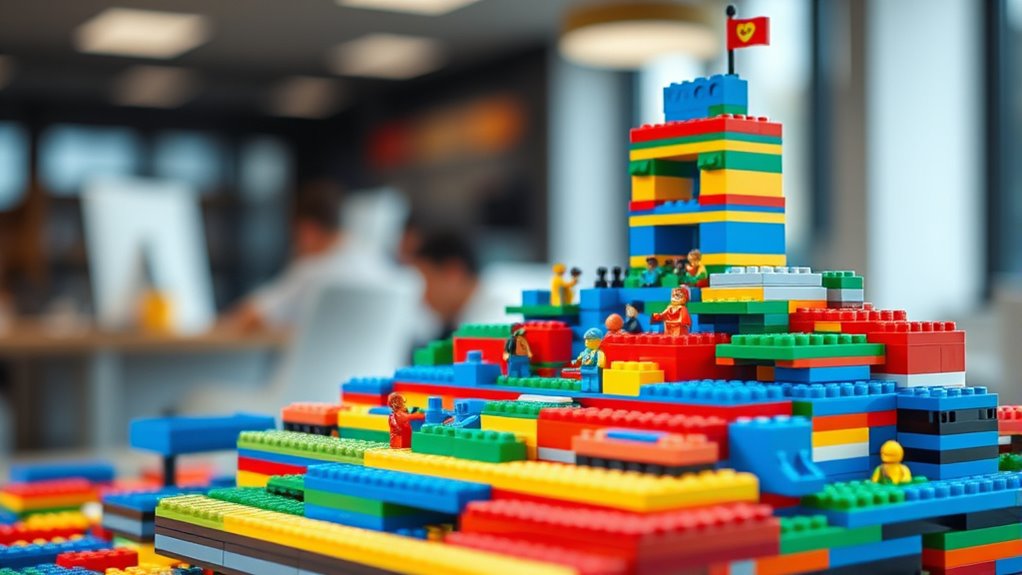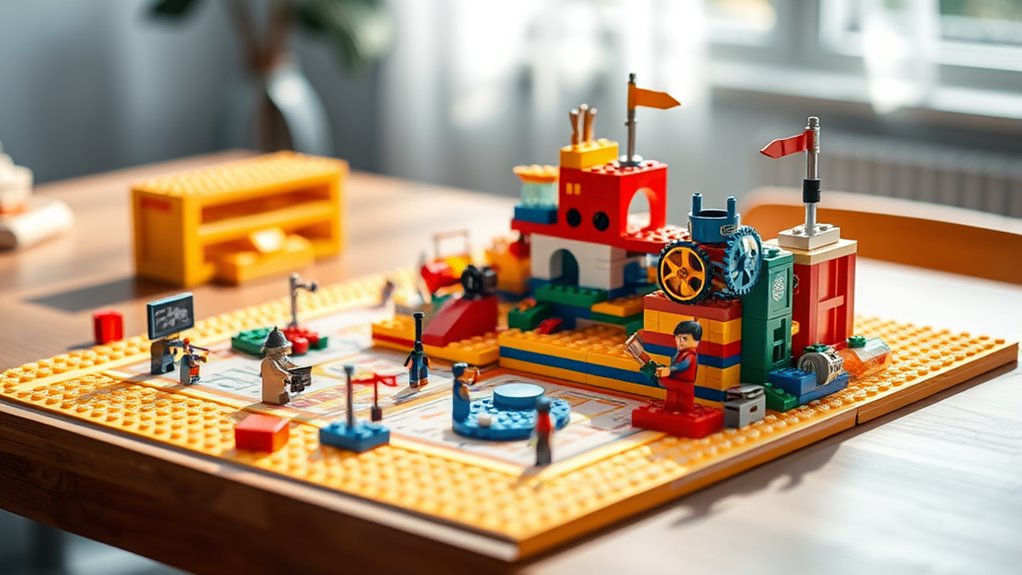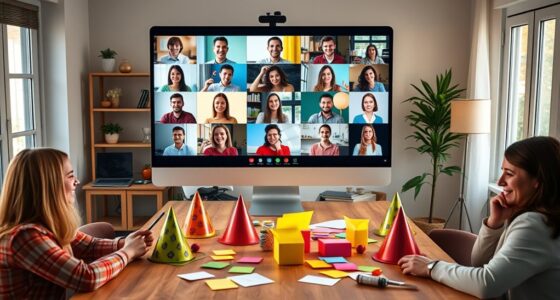The Lego Serious Play formula is about building strategy brick by brick through a structured, hands-on process. You’ll start by expressing ideas with LEGO bricks, creating models that visualize complex concepts. Facilitators guide you to connect these models, fostering creativity, open communication, and collaboration. This method transforms abstract thoughts into tangible outcomes, helping teams identify gaps and develop clear strategies. If you want to access more insights, explore how each step can enhance your planning and innovation efforts.
Key Takeaways
- The Lego Serious Play formula combines tactile building, storytelling, and facilitation to translate abstract strategies into tangible models.
- It follows a structured process: warm-up, individual building, group sharing, and connecting models for strategic insights.
- The methodology encourages open communication, creativity, and diverse perspectives through open-ended questions and visual storytelling.
- Facilitators guide sessions to align models with strategic goals, identify gaps, and develop actionable plans brick by brick.
- The approach fosters collaboration, trust, and mental clarity, allowing teams to build a shared strategic understanding step by step.
Understanding the Core Principles of Lego Serious Play

Lego Serious Play is built on a set of core principles that guide its effective use in facilitation and problem-solving. Tactile engagement is central—you actively manipulate LEGO bricks to express ideas, fostering deeper understanding. This hands-on approach keeps your mind engaged and encourages creative thinking. Visual storytelling is equally vital; as you build, you translate abstract concepts into tangible models, making complex issues easier to grasp. These principles break down traditional communication barriers, allowing everyone to contribute equally. By combining tactile engagement with visual storytelling, you access insights that might remain hidden in words alone. This approach transforms conversations into dynamic, collaborative experiences, helping you and your team build clarity, develop innovative solutions, and achieve shared goals more effectively. Dynamic communication exercises can further enhance collaborative building by promoting open dialogue and vulnerability.
The Step-by-Step Process of the LSP Methodology

To effectively utilize the Lego Serious Play (LSP) methodology, it’s important to follow a structured process that guides participants through each stage. You begin with an individual warm-up, encouraging participants to share ideas using simple brainstorming techniques to foster openness. Next, you move into building and storytelling, where team bonding is strengthened as members share their models and insights. Facilitators then guide discussions to connect individual models, promoting understanding and alignment. This step-by-step approach guarantees everyone’s voice is heard and ideas are visualized clearly. The process can be tailored to include various activities, such as integrating visualization techniques to enhance clarity and engagement. By systematically progressing through these stages, you create a collaborative environment that liberates creativity, enhances communication, and builds trust. Following this process helps make certain that your LSP sessions are productive and impactful.
Techniques to Foster Creativity and Open Communication

Creating an environment that encourages creativity and open communication starts with employing specific techniques designed to break down barriers and stimulate ideas. Focus on mindset development by encouraging participants to adopt a growth-oriented attitude, fostering confidence to share unconventional ideas. Use team bonding exercises to build trust, making members more comfortable expressing themselves. Incorporate activities like rapid ideation or storytelling with LEGO bricks, which help participants visualize thoughts and spark spontaneous conversations. Emphasize active listening and positive reinforcement to reinforce openness. By creating a safe space where all voices are valued, you enable your team to explore innovative solutions without fear of judgment. Understanding cookie categories and managing user consent effectively can also contribute to a more comfortable and trustworthy environment for participants. These techniques help release collective creativity and lay the foundation for effective collaboration.
Practical Applications of Lego Serious Play in Strategic Planning

When it comes to strategic planning, leveraging Lego Serious Play offers a hands-on approach that transforms abstract ideas into tangible models, making complex concepts easier to understand and analyze. You can use it to improve team collaboration by encouraging everyone to physically build their perspectives, fostering diverse input and shared understanding. It’s especially effective in innovation workshops, where visualizing future scenarios sparks creativity and unblocks new solutions. By constructing models that represent goals, challenges, or strategies, your team can identify gaps, align priorities, and develop actionable plans more effectively. This interactive method bridges communication gaps and keeps everyone engaged, ensuring that strategic discussions are dynamic and inclusive. Incorporating mental clarity and health techniques into the process can further enhance focus and creativity. Overall, Lego Serious Play brings clarity and cohesion to the strategic planning process.
Tips for Facilitating Successful LSP Sessions

Facilitating a successful Lego Serious Play (LSP) session requires more than just explaining the activity; it demands preparation, clarity, and engagement. To boost team engagement, set clear objectives and create a safe environment where everyone feels comfortable sharing ideas. Use visual storytelling to help participants express complex thoughts through their Lego models, making abstract concepts more tangible. Encourage open-ended questions that invite diverse perspectives and foster collaboration. Keep the pace lively to maintain energy and focus. As a facilitator, stay attentive to group dynamics and adapt your approach as needed. Remember, your role is to guide rather than dominate, helping the team build a shared understanding brick by brick. Cultivating a growth mindset can enhance participants’ openness to new ideas and learning during the session. Effective facilitation transforms LSP into a powerful tool for strategic insight.
Frequently Asked Questions
How Does Lego Serious Play Compare to Other Strategic Planning Tools?
When comparing Lego Serious Play to other strategic planning tools, you’ll find it offers tangible engagement and boosts creative thinking. Unlike traditional methods, it involves hands-on activities that make ideas concrete and accessible. This approach encourages active participation, helps uncover insights, and fosters collaboration. You’ll likely find it more dynamic and memorable, making strategic sessions more effective and engaging than purely verbal or paper-based tools.
Can Lego Serious Play Be Adapted for Virtual or Remote Teams?
Think of Lego Serious Play as a bridge that can extend across digital gaps. You can adapt it for virtual teams by using online collaboration tools, digital Lego sets, or creative shared spaces. This virtual adaptation boosts remote engagement, allowing team members to build and share ideas regardless of location. With some flexibility, you turn physical play into a powerful strategy tool that unites your remote team and sparks innovation.
What Are Common Challenges Faced During LSP Sessions?
When you facilitate LSP sessions, you often face challenges like groupthink, which can limit diverse ideas, and maintaining participant engagement, especially if some members feel hesitant. You need to create a safe environment where everyone feels comfortable sharing. Encouraging open dialogue and using varied activities helps break down barriers, ensuring all voices are heard and fostering creative collaboration. Overcoming these challenges leads to more effective and insightful sessions.
How Do You Measure Success or Outcomes From Lego Serious Play?
Did you know 85% of participants report increased engagement after LSP sessions? To measure success, you should evaluate impact by observing how well participants articulate ideas and collaborate. Track changes in team dynamics, problem-solving, and decision-making. Gathering feedback and reflections helps assess whether the session met its goals. By actively measuring impact and evaluating engagement, you gain clear insights into how effectively LSP builds understanding and fosters innovation within your team.
Is There an Ideal Group Size for Effective LSP Workshops?
You’ll find that an ideal group size for effective LSP workshops usually ranges from six to twelve participants. Smaller groups foster better group dynamics, ensuring everyone has a chance to participate and share ideas, which boosts participant engagement. Larger groups can work too but might require more facilitation to keep everyone involved. Ultimately, the right size depends on your workshop goals and the level of interaction you want to achieve.
Conclusion
Now that you’ve uncovered the blueprint of Lego Serious Play, you’re ready to craft your strategies brick by brick. Think of it as opening a treasure chest of creativity and collaboration, where each piece you build reveals new insights. With the right techniques and open communication, you’ll lay a solid foundation for innovation. So, pick up those bricks and start building—your next breakthrough is just a few blocks away, waiting to be shaped by your hands.








